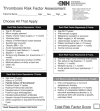Validation of the Caprini risk assessment model in plastic and reconstructive surgery patients
- PMID: 21093314
- PMCID: PMC3052944
- DOI: 10.1016/j.jamcollsurg.2010.08.018
Validation of the Caprini risk assessment model in plastic and reconstructive surgery patients
Abstract
Background: The Venous Thromboembolism Prevention Study (VTEPS) Network is a consortium of 5 tertiary referral centers established to examine venous thromboembolism (VTE) in plastic surgery patients. We report our midterm analyses of the study's control group to evaluate the incidence of VTE in patients who receive no chemoprophylaxis, and validate the Caprini Risk Assessment Model (RAM) in plastic surgery patients.
Study design: Medical record review was performed at VTEPS centers for all eligible plastic surgery patients between March 2006 and June 2009. Inclusion criteria were Caprini score ≥3, surgery under general anesthesia, and postoperative hospital admission. Patients who received chemoprophylaxis were excluded. Dependent variables included symptomatic deep vein thrombosis (DVT) or pulmonary embolism (PE) within the first 60 postoperative days and time to DVT or PE.
Results: We identified 1,126 historic control patients. The overall VTE incidence was 1.69%. Approximately 1 in 9 (11.3%) patients with Caprini score >8 had a VTE event. Patients with Caprini score >8 were significantly more likely to develop VTE when compared with patients with Caprini score of 3 to 4 (odds ratio [OR] 20.9, p < 0.001), 5 to 6 (OR 9.9, p < 0.001), or 7 to 8 (OR 4.6, p = 0.015). Among patients with Caprini score 7 to 8 or Caprini score >8, VTE risk was not limited to the immediate postoperative period (postoperative days 1-14). In these high-risk patients, more than 50% of VTE events were diagnosed in the late (days 15-60) postoperative period.
Conclusions: The Caprini RAM effectively risk-stratifies plastic and reconstructive surgery patients for VTE risk. Among patients with Caprini score >8, 11.3% have a postoperative VTE when chemoprophylaxis is not provided. In higher risk patients, there was no evidence that VTE risk is limited to the immediate postoperative period.
Copyright © 2011 American College of Surgeons. Published by Elsevier Inc. All rights reserved.
Figures




References
-
- Wakefield TW, McLafferty RB, Lohr JM, et al. Call to action to prevent venous thromboembolism. J Vasc Surg. 2009;49:1620–1623. - PubMed
-
- Centers for Medicare and Medicaid Services. press release, April 14 2008. http://www.cms.hhs.gov. - PubMed
-
- National Quality Forum. press release, May 15 2008. http://www.qualityforum.org.
-
- Green D. VTE prophylaxis in aesthetic surgery patients. Aesth Surg J. 2006;26:317–324. - PubMed
-
- Bahl V, Hu HM, Henke PK, et al. A validation study of a retrospective venous thromboembolism risk scoring method. Ann Surg. 2009 Sep 22;241:344–50. - PubMed
Publication types
MeSH terms
Substances
Grants and funding
LinkOut - more resources
Full Text Sources
Medical

